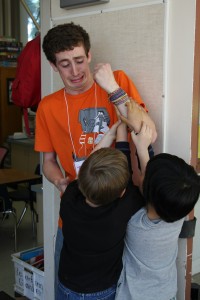
His sky-blue basketball shorts draped over a pair of pale, knobby knees, and his curly brown hair formed into the kind of Afro that was years out of style. The 13-year-old boy stood alone in the middle of the locker room, not a gym teacher in sight to patrol his far more muscular (and far less prepubescent) company.
Before he could say a word, three large boys huddled around him, blocking any hope of escape. They grabbed his shoulders and torso and thrust him high into the air. A crowd formed around them; he could hear their laughter as he hurtled back to earth. Now the boys had him in a headlock, and they raced his body towards the nearest Dumpster, letting his head bob up and down with the speed of their run. In a swift motion he was catapulted face first into a fly-ridden bed of days-old yogurt and half-eaten burritos.
As his skinny legs flailed, the other boys laughed even louder. Mission complete.
It was the kind of scene young readers cherish in Teddy Steinkellner’s adolescent-oriented stories. But in this case, fiction does more than echo reality. The humiliation didn’t just scar the main character of Steinkellner’s first book, “Trash Can Days: A Middle School Saga,” it happened to the author when he was 13.
And in many ways, Steinkellner – Stanford graduate, successful writer and 24-year-old adult – is still that 13-year-old kid.
He says his spirit animal is a wind noodle at a used-car dealership (“constantly flailing about and smiling in a slightly unsettling way”) and, true to form, his body operates like one. He bounds into his apartment for an hour-long interview, takes a running start from behind the couch, leaps over the backside and lands his butt on one of the cushions. He proceeds to wrap his entire body in a purple blanket so only his head pops out. “I’m ready to be interviewedddd!” he squeals.
Though Steinkellner owns a closet full of pants, he wears the same red Stanford basketball shorts almost every night and has for the last half decade. “They’re the grilled cheese of shorts,” he says, joking that the one time his girlfriend almost lost them at a Laundromat nearly caused them to break up.
His bookshelf contains several Aladdin action figures, and next to photos of him and his girlfriend on his refrigerator are magnets of various safari-type animal’s butts (no bodies, heads or torsos, just their butts).
This youthful disposition might be considered a liability for an author navigating the adult world of publishing. There are contracts to negotiate, book tours to organize, and meetings with agents who’ve read more literary submissions than they can count. But for now, for Teddy Steinkellner, who recently signed a contract for a third book, it’s the secret to his success.
Growing up in a family of storytellers, Steinkellner began writing as a young boy in Santa Barbara, California. His parents are screenwriters with such credits as “Cheers” and “The Jeffersons.” They encouraged their three children to pursue creative interests, prompting Steinkellner to write plays and short stories.
“His first published poem, a ‘Random Autobiography,’ was published when he was 6 years old,” says Cheri Steinkellner, his mother. “Other early works include a book he wrote and illustrated called ‘Corvus The Crow,’ a re-telling of The Gingerbread Boy, and a couple of plays produced in high school.”
It wasn’t until Steinkellner found himself with his first free summer, before junior year at Stanford, that he decided to try his hand at writing something more complex: a 352-page novel.
“It’s silly to call it a ‘heroic calling,’” he says. “But there was this voice telling me I wanted to try something really big during that time, something that I could really fail at. I was never going to develop an app or start a nonprofit to help kids get clean water or something like that, but I had writing and parents who were okay with me bunkering in my room for the summer and just writing, writing, writing.”
After approval from his mom to live at home one last time without paying rent, Steinkellner produced the first draft of what would become his first novel. “Trash Can Days: A Middle School Saga” is the story of two boys and two girls exploring the murky waters of adolescence, told in their voices.
Steinkellner chose to write about middle-schoolers because he felt (at age 19) he had a fair degree of authority on that stage of life, with the benefit of some distance. He also sensed an underrepresentation of that age group in media, film and books.
“Nobody in my recollection and experience had a good go of it in middle school really. I mean, the unpopular kids were tormented by the popular kids and the popular kids had the internal torment of trying to remain popular. No one had fun, and I think because everyone hates middle school so much that’s part of why you don’t see that much fiction or you don’t see that many stories about middle school comparatively.”
That’s where Steinkellner’s choice of topic and spirit animal merged to create a novel that Christian Trimmer, an acquisitions editor for Simon and Schuster, jumped at the chance to publish. “Teddy’s novel was in amazing shape from the get-go,” says Trimmer, one of the first people to read the draft of “Trash Can Days.” “He nailed the voices of his four main characters, and the plot flowed very smoothly.”

The book features four characters who don’t just channel the personality of a young Steinkellner. It switches between narrations by Jake Schwartz, an awkward, nerdy boy who clearly mimics Steinkellner; Danny Uribe, Jake’s best friend and the son of his parents’ live-in maid and gardener; Hannah Schwartz, Jake’s older sister and their middle school’s Queen Bee; and Dorothy Wu, a creative and outcast seventh-grader who subsists by writing epic stories of warrior mermaids.
The plot incorporates key scenes around coming of age: attending middle-school dances, being bullied, and having crushes. Also layered in are the characters’ deeper conflicts. (Danny, for instance, whose parents are Hispanic and far less well-off than Jake’s, begins distancing himself from Jake as he faces pressure to join a gang.)
The diversity of these characters also prompted diversity in the book’s reception. Some online review sites display comments from readers who feel – perhaps due to Steinkellner’s life in no way resembling a character like Danny’s – the author inaccurately portrays the middle school experience.
Lisa Wolf, author of the book review website “Bookshelf Fantasies,” wrote: “Between the Hollywood producer’s kids’ privileged lives, the gang turf wars, the online cattiness, and the ‘slut shaming’ that happens far too frequently in a relatively short period of time, I felt that the content was not believable or realistic, given the ages of the characters.”
A few older readers shared this view. Most of the negative reviews for “Trash Can Days” on “Goodreads” (currently the most popular website for consumer book reviews and ratings) criticize it for the kids “acting much older” and seeming “too advanced.” Fortunately for Steinkellner, praise for his book has eclipsed the negativity.
After Steinkellner graduated from Stanford, Disney Hyperion immediately offered him his first publishing contract. Since then, the success has continued to flow. “Trash Can Days” received a positive review in The New York Times, Steinkellner just finished a short book tour, and the sequel to “Trash Can Days” (“Trash Can Nights”) is scheduled to come out in July.
But if Steinkellner’s personality was the key to channeling the voices of young adults, it’s also where one of his greatest challenges comes in. Sara Crowe, an agent who specializes in young adult literature at Harvey Klinger, Inc. notes in Publisher’s Weekly that pressure to accurately capture the voices of adolescents is only rising with increased competition in the young adult market.
“I actually think manuscripts have gotten stronger,” she says in the Publisher’s Weekly interview. “There are so many more agents involved in YA [young adult] these days. Everything is more competitive.”
For Steinkellner, this problem is exacerbated by the fact that he’s writing about a generation in an era of constant change, and he’s getting older too.
“Technology – and the rapidly changing technology – is a crucial aspect of being a kid these days,” Steinkellner says. “It’s tricky to put stuff in that you’re gonna be embarrassed by later on.” For instance, when Steinkellner wrote the first draft of “Trash Can Days,” he made reference to Hannah Schwartz refreshing her Facebook news feed to stay up to date on the latest gossip. “By the time I sold the book,” Steinkellner says, “Facebook’s news feed refreshed itself.”
Despite how quickly new forms of technology can become outdated, Steinkellner chose not to set the book in a falsely technology-free world. Rather, he incorporates Facebook and social media into his books as a way to more authentically capture the tweens of today.
When Hannah Schwartz needs a way to distract her classmates from a recent humiliating moment in her life, she creates her own gossip blog, “Dirty Little Secrets,” as a way to judge and assess her peers:
“So that is the fourth and so far juiciest post of my all-new blog,” says Hannah Schwartz in the second half of “Trash Can Days.” “It’s only been up a few hours and already it’s got 216 hits. Yeah, I know, basically I’ve reached phenomenon status. Dirty Little Secrets is the biggest thing to hit San Carlos since Chicle Rodriguez’s butt. Oooh, that’s so harsh, I know. Once I get into gossip blog mode, it’s kinda hard for me to switch out.”
Another way Steinkellner stays current is by constantly doing his research.
“I’m blessed with a lot of Facebook friends of all ages,” he says. “Sometimes I’ll lurk on there to get little bits of information, little phrases, little details and all that. I’m kind of always taking in research in that way.”
So as Steinkellner begins to think about the future, how will he maintain what he’s built? “Anyone who gets a book deal at all is a rarity,” says Trimmer. “Even rarer is selling the first thing you’ve written.”
While Steinkellner says he finds joy in knowing he fulfilled a childhood dream by selling and publishing a children’s book, he’s not fully satisfied.
“What constitutes success in my own mind is constantly shifting and moving just past where you can reach it. In the very beginning, the dream was to finish a book, publish it. Then you want it to be placed well. Once you do that you want a lot of people to buy it, awards. In my own head I try not to get too caught up in that.”
Steinkellner’s mother says she and her husband felt similar apprehensions with his early success.
“We were … concerned that when you strike it big very early the bar is set so high it can be hard to rebound, hard to go the distance,” she says.
Dealing with these challenges, and the prospect of future failure, might again be where his childlike spirit animal (a wind noodle that when blown in any direction continues to smile carelessly) serves him well.
As he says, “I borrow a concept I learned from improv. If I fail, whether on a large or small scale, I want to act like a trapeze artist that falls to ground, stands up and yells, ‘Tada!’ In that way, I want every failure to turn itself into a tiny triumph.” Just like the time Steinkellner crawled out of that burrito-filled Dumpster, dusted himself off and years later used the experience as inspiration for a book.
“To write itself is to fail constantly and daily,” Steinkellner says. “And you have to just get over it. Constantly and daily.”
Editor’s note: The author of this article is the sister of Steinkellner’s girlfriend, who remains careful not to misplace his favorite pair of shorts.
